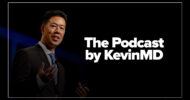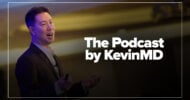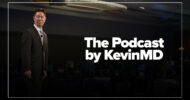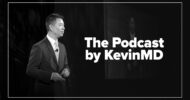Subscribe to The Podcast by KevinMD. Watch on YouTube. Catch up on old episodes!
Family physician Jay K. Joshi discusses his article, “Why patients and doctors are ditching insurance for personalized care.” He explains that as traditional insurance becomes less accessible and covers fewer proactive and preventive services, both patients and physicians are seeking alternatives. Jay outlines a direct-pay model, often focused on functional medicine approaches like metabolic optimization, hormone therapy, and advanced diagnostics, which strategically integrates financial planning into the care itself. This model utilizes tools like educating patients on Health Savings Accounts (HSAs), offering flexible payment plans through third-party financing, and implementing subscription-style payments for longitudinal care. Jay stresses the importance of empathetic, transparent communication about costs, framing them as investments and normalizing financial tools to reduce stress and improve adherence. He argues that such direct-pay structures empower patients, enhance clinical decision-making autonomy, and represent a vital evolution in health care delivery focused on accessibility and outcomes.
Our presenting sponsor is Microsoft Dragon Copilot.
Want to streamline your clinical documentation and take advantage of customizations that put you in control? What about the ability to surface information right at the point of care or automate tasks with just a click? Now, you can.
Microsoft Dragon Copilot, your AI assistant for clinical workflow, is transforming how clinicians work. Offering an extensible AI workspace and a single, integrated platform, Dragon Copilot can help you unlock new levels of efficiency. Plus, it’s backed by a proven track record and decades of clinical expertise and it’s part of Microsoft Cloud for Healthcare–and it’s built on a foundation of trust.
Ease your administrative burdens and stay focused on what matters most with Dragon Copilot, your AI assistant for clinical workflow.
VISIT SPONSOR → https://aka.ms/kevinmd
SUBSCRIBE TO THE PODCAST → https://www.kevinmd.com/podcast
RECOMMENDED BY KEVINMD → https://www.kevinmd.com/recommended
Transcript
Kevin Pho: Welcome to the show. Subscribe at KevinMD.com/podcast. Today we welcome back Jay K. Joshi. He’s a family physician. Today’s KevinMD article is “Why patients and doctors are ditching insurance for personalized care.” Jay, welcome back to the show.
Jay K. Joshi: Thank you for having me. Always good to talk to you.
Kevin Pho: So tell us what your latest article is about.
Jay K. Joshi: I really want to emphasize the changing nature of health care in this post-pandemic world. One of the biggest changes is that the fundamental institution of health insurance, as we understand it, both explicitly and implicitly, has changed.
What I mean by that is we know that patients have had a long-drawn-out fatigue of health insurance companies, and we don’t need to get into the politics of it, but it’s now more apparent than ever. Implicitly now, people are starting to recognize that health insurance isn’t the end-all and be-all of the health care experience.
Previously, going as far back as the eighties and nineties, health insurance companies effectively deemed in the minds of many what is valuable, what is worthy in health care. We’re shifting away from that. As we start to shift away from that, it’s really incumbent on the patients and the physicians to reunite and focus on what values to them in their patient care experience.
Kevin Pho: And how did we get to this point where we gave insurance companies so much power that they themselves can deem what’s worthy in health care?
Jay K. Joshi: It’s essentially a death by a thousand knives, right? There’s not any one incident that really happened as much as there was just a series of default reactions. Health insurance provided a means for patients to defer payments. That made a lot of sense. Health insurance provided a way for physicians to get compensated without directly engaging with the patients and avoiding awkward conversations; that made sense.
Then over time, they became the thousand-pound gorilla in the room and effectively dictated the nature of the relationship between the patient and the physician. What I propose is that we need to go back to that one-on-one relationship. It makes a lot of sense in that it’s a good thing: direct patient-to-physician relationships. But it’s also going to bring back awkward conversations that many physicians thought they’d never have, for example, discussing finances with patients. That’s something that’s anathema to a lot of physicians in the sense that they’re conditioned not to want to talk about finance.
But what I propose is that not only should you jump into those conversations, you should, in the same vein as health insurance companies do, find ways where patients can utilize affordable payment mechanisms. So instead of avoiding the conversation, jump into it and help patients realize there are ways you can pay for your health care directly that goes around simply having to pay up a lump fee.
Kevin Pho: And you mentioned how finances are anathema to how physicians are trained, and that goes for the practice environments physicians often find themselves in, right? Because whenever they finish residency, they just don’t have a lot of that background, so they choose practices where they’re divorced from the realities of finance.
Jay K. Joshi: Right. And I think that served physicians in an era before the pandemic. What we have to recognize is that the pandemic has primary-order consequences, as we can see in the news all day, every day, but there are also second- and third-order consequences that are more subtle. One of those subtle changes is the avoidance of health insurance as the end-all and be-all when it comes to the health care experience.
So what I propose is to look at it in its full context. Whenever you tell patients or you tell physicians, “Hey, let’s eliminate health insurance companies,” everybody just reflexively says, “Hey, that’s a great idea.” But they don’t see the full consequence of that. Part of that involves conversations where it may be awkward to talk about this with my patients. It was better when health insurance took care of that. Oh, but health insurance is not taking care of that anymore. You mean coverage is dropping? You mean now I have to bring forward that conversation?
So these types of thought patterns appear in the minds of many physicians. What I suggest is recognizing that financial literacy is a part of good clinical care.
In the oncology space, there is this term called financial toxicity. What it entails is that after a patient typically completes a course of chemotherapy, they’re at a very high likelihood of going bankrupt or needing some sort of bankruptcy-type relief. What oncologists have noticed is that they may beat the cancer, but the patient loses out economically. So you have to look at economics and finance as a social determinant of health in that capacity. Good financial literacy is a part of good clinical care.
When you frame it in that context, it no longer becomes an awkward conversation around finances. It actually becomes part of good clinical care to help patients understand, “Hey, you need to budget X, Y, and Z for your medical expenses. How can we make this cost-effective? How can we make this tax-beneficial?” Jump into conversations on health savings accounts, on payment deferment plans.
So we actually partner with different financial institutions that will say, “Hey, why don’t you open up a health savings account? You can save a lot of money.” And there are those patients that say, “Oh, way ahead of you. We’ve had a health savings account for decades.” And some patients will say, “Health savings account, is that a thing?” That’s when you start to educate patients to say, “Look, you’re going to have to budget more out-of-pocket expenses for health care. Find a way to do it in the best way, tax-wise.” You’re talking to them like you would talk to a colleague. In many ways, that’s the essence of good clinical care, right? It’s an ongoing narrative between the patient and the physician that encompasses all aspects of health care.
Kevin Pho: So talk to me about some of the models that you are proposing where we could incorporate some of that financial literacy with patients. What would that look like?
Jay K. Joshi: Sure thing. What I begin with is replicating how health insurance companies offer their support. They offer their support by providing compensation for financial services in exchange for ongoing subscription-based payments, right? They just use different words: they call it premium, they call it deductibles, what have you. But essentially, health insurance companies are money in, money out, and to the patient, it appears as an ongoing subscription payment.
So patients are used to that mechanism of payment. How can we replicate that mechanism of payment so that behaviorally it appears familiar to patients, but we’re devoid of the health insurance entity itself?
You can offer deferred payments. You can offer, through financial institutions like PatientFi, Cherry, what have you—pick your litter of them. There’s a whole cottage industry of these types of third-party financing vehicles that can allow for third-party financing, often at no interest if you’re able to make the payments within a certain timeframe. Then it becomes something very familiar. It becomes something that’s patient-to-physician, but the patient on their side, and their financing, looks like something very similar to what insurance companies offer.
So behaviorally, you have the familiarity of ongoing recurring payments at a discounted price, but it avoids having to go through the insurance companies, the prior authorizations. It’s a direct relationship between what the patient wants in terms of clinical care and what the physician offers in terms of clinical expertise.
Kevin Pho: So this sounds similar to, or is like, those direct primary care models, direct care models, where they charge a subscription fee for services rendered. Is that fair to say?
Jay K. Joshi: I would put it in two ways. Behaviorally, it’s very similar, right? The whole construct of providing recurring payments over time. I think direct primary care is a great model in having these membership-based payments. Oftentimes patients will gravitate towards it because they’ll see, “Hey, I just have to pay a lump sum upfront.” But it’s not the end-all, be-all. What I would encourage physicians to do is to explore different types of models.
So conduct this cognitive experiment. What we’re presenting to the patient is a series of recurrent payments over time, a subscription-based payment model. What is entailed in that subscription-based model? Is it, as you proposed, a direct primary care model where there’s a membership fee, and then everything else is included? Or is it on a per-clinical-service basis that’s then paid over time?
You can mix and match different types of financial compensation models for clinical services rendered, whether you lump them as one membership fee or whether you individualize them based on clinical services.
It’s really about exploring that with the patient and getting a sense of what the patient is familiar with. What we find is a lot of people will look at these models and say, “Oh, direct primary care membership model. That makes sense.” Or, “Oh, insurance-based model. That makes sense.” What I would challenge a lot of physicians and a lot of providers in general is to look at it more cognitively. Look at what behavioral patterns of payments patients are familiar with, and how can we replicate that in a way that’ll cover either services in bulk or services individually.
Kevin Pho: Now, do you individualize these payment plans or payment models for each patient based on what they’re most comfortable with?
Jay K. Joshi: I have. What I found to be most attractive to patients is to identify one or two clinical services and focus on packaging a financial plan within those clinical services, then focusing on just those. The membership model is great for those of a certain socioeconomic bent that have the means to say, “Hey, here you go. Give me everything that I want.”
A lot of times in this environment, where patients are a little more consumer-sensitive, they want to pick and choose. They almost appreciate the fact that you are valuing their dollar in creating these financial packages. So it almost becomes a way to build a patient-physician relationship by understanding the price sensitivity of the average patient these days.
Kevin Pho: How do you scale that? Because if every patient has a different payment model, and obviously you’re a practicing physician yourself, how do you keep track of all that and how can you scale it?
Jay K. Joshi: Yes, I think the issue of scalability has yet to be resolved, but it’s almost where I don’t want to scale, if you will. When you scale, then you yourself have to introduce elements of consumerism, and I think that’s when you start to detract from the patient-physician relationship. I think the best type of relationship is one where you may sacrifice scalability, which is fine, but then you focus on individuality, which is what patients prefer in the first place.
We have a model in northwest Indiana. We’re in Hammond, Indiana, which is very much blue-collar, and Crown Point, Indiana, which is a little more affluent. The patient proclivity toward spending is the same: they’re both price-sensitive, and they’ve developed these relationships with money and health care based on how they’ve been treated by health insurance companies.
In that vein, you have to recognize the money spent is less about the absolute dollars and more about the perception of the dollar spent relative to the clinical value-add. And you’re right; I don’t really have a good answer to the question of scalability. I’m sure some private equity folks are penciling away on their own Excel spreadsheets, but what I have is a model that could individualize the care experience for patients.
Kevin Pho: So talk a little bit about your practice. How does it work? How many patients do you see? How big is your practice?
Jay K. Joshi: Yes, so we have a blend of clinical care focus. We see on average around 80 patients a week between both locations. So it’s a decent size, nothing out of the ordinary by any means, but it’s good enough for us to have a strong relationship with our patients.
What we focus on are specific conditions like weight loss, muscle enhancement, and hormone replacement, but we very much focus on the comprehensive primary care vein. So a lot of the weight loss patients that we treat will focus on behavioral economics; we’ll focus on behavioral changes. We’ll implement a fasting schedule; we’ll implement an exercise regimen.
For patients who are on muscle enhancement, we’ll often identify national thought leaders in the exercise regimen space to then give them a workout model that will incorporate a diet, exercise, and a peptide therapeutic within that space. There’s a whole slew of buzzwords out there: you talk about regenerative medicine, you talk about functional health. What we focus on really is just what the patient wants to target, what their end goals are, what is an appropriate monthly spend, and then how can we get to their goals in the most cost-effective manner.
Kevin Pho: So do you see this approach spreading among private practice physicians who would have more of that flexibility to implement their own payment models?
Jay K. Joshi: I think so. And I think it’s going to be localized. I’ve always been leery of the introduction of consumerism or standardization in health care because I think the model that works for me in northwest Indiana is not going to work in Central Tennessee, and it’s not going to work in Southern California. Those patients have different relationships with health insurance companies. Those patients have different experiences when it comes to finance and health care, and those physicians in that area have a better sense of the financial pain points for the patients. So they’re going to create slight variations on those models.
I think physicians should really delve deep into understanding what the patient values in the current health care experience.
Many patients are turned off by the model where you go to your primary care every three months, every six months, get a medication refill, wait three hours for three minutes of a physician’s time, and then go to a retail pharmacy and pick up your medications. The pandemic broke the mold. Whatever cognitive inertia existed in the mind of patients to say, “This is how health care must work,” the pandemic broke that. That’s a second- and third-order consequence. Now patients say, “What value can you provide for me if I’m going to invest time and energy in this health care experience?”
Many may say, “Well, that takes away from physician autonomy. It takes away from the cultural legacy of physicians as respected members of the community.” I would argue that it’s incorporating a lot of elements of patient autonomy that came about during the pandemic that, for better or for worse—I would say better, some would say worse—are here to stay. Patients now value… there’s an interesting Pew Research poll on where patients generate trust when it comes to health care. And it was neck and neck, this was in 2022, between their primary care physician and what they experience on social media.
What that tells you is that patients now see themselves as purveyors of knowledge when it comes to the health care experience. The knowledge curated by the patient himself or herself is deemed as valuable as the clinical knowledge passed on from the physician. We have to respect that, and we have to navigate that landscape if we want to have a viable model when it comes to health care.
I think a lot of times when people talk about frustration in health care, yes, there’s the administrative burden, but I also think a silent burden is the changing relationship when it comes to patients.
No longer can a physician say, “Hey, based on your demographics and predisposition to high blood pressure, I think you should take amlodipine instead of lisinopril.” And then a patient may say, “Well, I ‘researched’ lisinopril, and I think that might be better for me. What do you have to say?” Right away the physician may think, “Do you even know what research means? Do you even know the difference between lisinopril and amlodipine? Why are we having this conversation?” And it can turn negative very quickly.
Instead, the physician should understand, “Where did you get that information from? Let me share the medical knowledge that I have with the information that you’re gathering.” So it’s a pivot in the relationship. At some point you can say, “Potatoes, potatoes, what have you.” I would argue that those subtle nuances in how the conversation goes and how the physician appreciates the patient’s feedback are really the breaking factor in why patients value some physicians and don’t value other physicians.
Kevin Pho: We’re talking to Jay K. Joshi. He’s a family physician. Today’s KevinMD article is “Why patients and doctors are ditching insurance for personalized care.” Jay, let’s end with some takeaway messages that you want to leave with the KevinMD audience.
Jay K. Joshi: The biggest takeaway I would have for physicians listening to this is: empower yourselves to have financially oriented conversations with patients. Patients value those types of conversations, and whatever awkwardness or reluctance you might have will quickly go away. Start by having these conversations with patients that you’re most familiar with, that you know if the conversation turns awkward, it would not lead to any sort of negative or adverse effect. Start to get comfortable having those financially related conversations. Understand what questions the patients may have, and then over time incorporate that into your practice because we must, as physicians, understand the financial needs of patients if we’re going to provide good quality of care.
Kevin Pho: Jay, thank you so much for sharing your perspective and insight. Thanks again for coming back on the show.
Jay K. Joshi: Thank you, sir. I appreciate it.























![Sibling advice for surviving the medical school marathon [PODCAST]](https://kevinmd.com/wp-content/uploads/Design-1-190x100.jpg)




